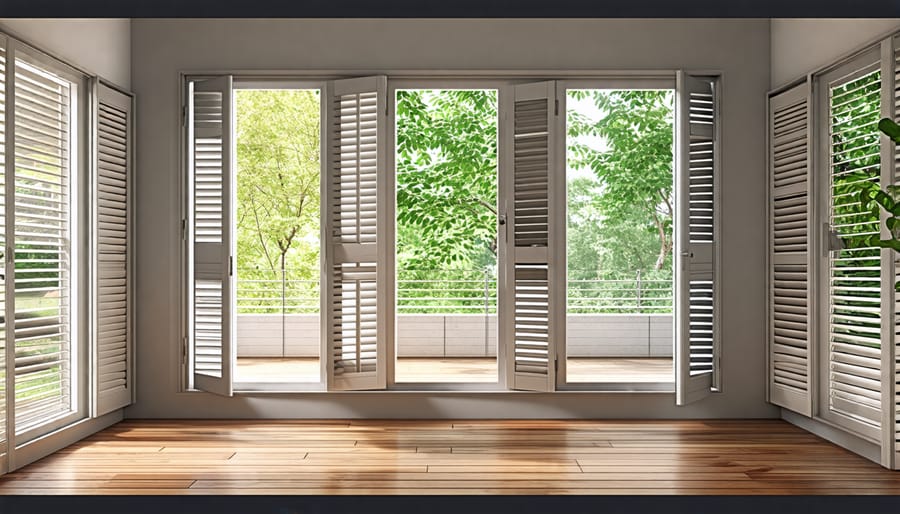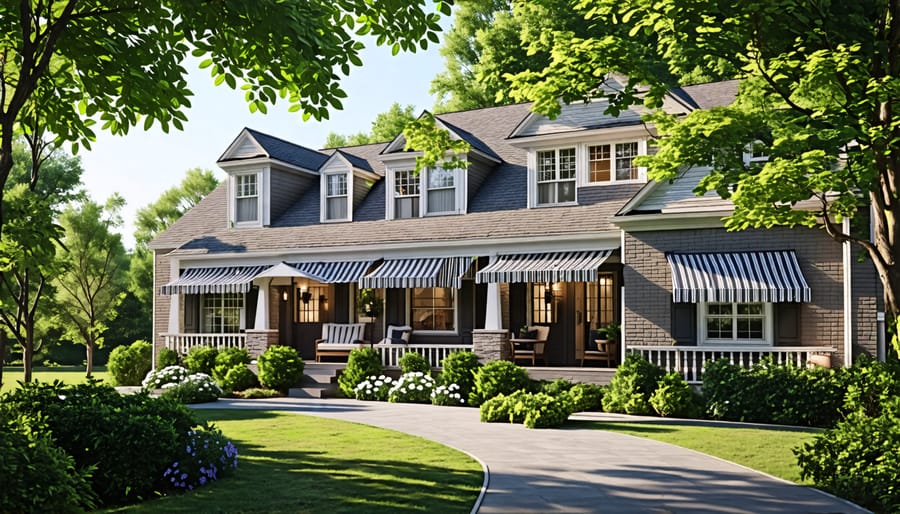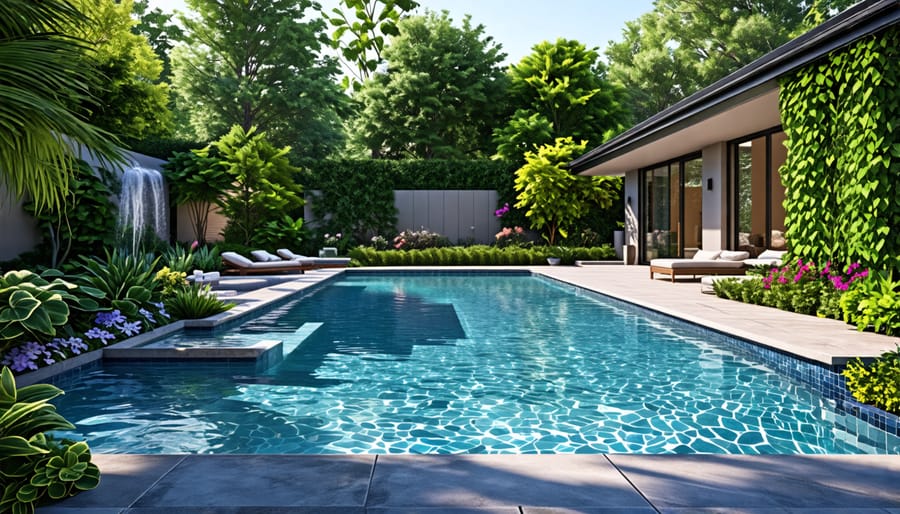Maximize natural ventilation by strategically placing windows on opposite walls to create cross breezes and exhaust hot air. Shade your home’s exterior with wide overhangs, awnings, trellises, or trees to block direct sun and reduce heat gain through windows and walls. Choose light-colored, reflective roofing materials and exterior paint to deflect sunlight and minimize thermal absorption. Insulate walls, ceilings, and floors to their maximum R-values to slow heat transfer into the home’s interior.

Maximize Natural Ventilation
Window Tricks
Windows are your allies in combating heat. Start by strategically opening windows at night when temperatures drop, allowing cooler air to flow in. In the morning, close windows and shades to trap the cool air inside. Consider installing reflective window films, which can block up to 78% of solar heat without compromising visibility. Exterior shades or awnings are also effective at preventing heat gain. Opt for light-colored, opaque shades to reflect sunlight while maintaining privacy. For a high-tech solution, invest in smart shades that automatically adjust based on temperature and sunlight. Don’t forget the simple power of cross-ventilation – open windows on opposite sides of your home to create a refreshing breeze. With these window tricks, you’ll keep your cool even as the mercury rises outside.
Design for Airflow
When designing your home for hot climates, promoting airflow is key to staying cool and comfortable. Consider open floor plans that allow air to circulate freely between rooms. Position windows and doors strategically to create cross breezes, drawing fresh air in and pushing hot air out. High ceilings can also help hot air rise away from living spaces. Installing ceiling fans or whole-house fans can further enhance air circulation. Opt for louvered or screened doors and windows to allow airflow even when closed. Strategically placed vents or transoms above doors can also promote air movement between rooms. Outside, consider designing covered outdoor living areas that catch cool breezes, and position trees or landscaping to funnel wind toward your home. By prioritizing airflow in your home design, you can create a more comfortable living environment that naturally stays cooler in hot weather.
Harness the Power of Shade

Shade Your Windows
Shading your windows is a highly effective way to keep your home cool in hot weather. Awnings are a great option, providing shade while still allowing some natural light. For more flexibility, consider installing shutters that can be adjusted to block sun at different angles throughout the day. Interior blinds or curtains made from light-blocking materials also help prevent heat gain. For a decorative touch, window boxes filled with lush plants can provide both shade and beauty. When choosing any window treatments, look for light colors that reflect rather than absorb heat. With these smart shading strategies, you can significantly reduce solar heat gain and maintain a more comfortable indoor temperature, even on the hottest days. Experiment with different combinations to find the perfect balance of shade, ventilation, and style for your space.
Living Shade
One effective way to shade your home naturally is by strategically planting trees, vines, and shrubs around the exterior. Deciduous trees provide cooling shade in summer while allowing sunlight through in winter. Tall shrubs and trellised vines can shield walls and windows from direct sun. Planting vegetation on the south and west sides blocks the most intense rays. As a bonus, plants release water vapor, creating a cooling effect around your home. Greenery also adds beauty and can attract birds and butterflies to your yard. With some thoughtful landscaping, you can harness nature to keep your home more comfortable in the heat.
Choose Cooling Colors and Materials
When it comes to home design for hot climates, one of the most effective strategies is to choose cooling colors and materials for your home’s exterior. Opting for light-colored exteriors can significantly reduce heat absorption, as lighter hues reflect more sunlight than darker ones. Consider shades like white, ivory, light gray, or pale pastels for your home’s walls, trim, and roof.
Speaking of roofs, selecting reflective roofing materials can make a world of difference in minimizing heat gain. Look for options like cool roof coatings, which are specially designed to reflect sunlight and reduce the amount of heat absorbed by your home. These coatings can be applied to various roofing materials, including metal, tile, and asphalt shingles.
In addition to color and reflectivity, the materials you choose for your home’s exterior can also impact its ability to withstand heat. Opt for materials with high thermal mass, such as brick, stone, or concrete, which absorb heat slowly during the day and release it gradually at night, helping to regulate indoor temperatures. Insulated concrete forms (ICFs) are another excellent choice, as they provide both insulation and thermal mass benefits.
When selecting materials for your home’s exterior, also consider their durability and resistance to heat-related damage. For example, vinyl siding can warp or melt under extreme temperatures, while fiber cement siding is more resilient and can help protect your home from the elements. Similarly, metal roofing is not only reflective but also highly durable and resistant to heat-induced wear and tear.
By carefully choosing cooling colors and materials for your home’s exterior, you can significantly reduce heat absorption and create a more comfortable living space during even the hottest months of the year.
Insulate and Seal
Keeping your home cool in a hot climate starts with proper insulation and air sealing. These crucial steps prevent hot outdoor air from seeping into your living spaces while keeping cooler, conditioned air inside where it belongs. Begin by assessing your home’s insulation levels, paying close attention to the attic, walls, and floors. Add insulation where needed to achieve recommended R-values for your climate zone. Don’t forget often-overlooked areas like attic knee walls, garage ceilings, and rim joists.
Next, meticulously seal any gaps, cracks, or openings in your home’s envelope using caulk, weatherstripping, and expandable foam. Target common air leakage spots like window and door frames, electrical outlets, and plumbing penetrations. For a thorough approach, consider hiring a professional to conduct a blower door test and identify hidden air leaks with thermal imaging.
By investing time and resources into proper insulation and air sealing, you’ll create a more effective thermal barrier between your home’s interior and the scorching outdoor temperatures. This not only leads to a more comfortable living environment but also reduces the workload on your cooling system, resulting in lower energy bills and a smaller environmental footprint. Remember, a well-insulated and sealed home is the foundation of efficient and sustainable cooling in hot climates.

Embrace Water Elements
Incorporating water elements into your home design can provide a cooling effect through evaporation while adding a serene, refreshing ambiance. Consider installing a pool in your backyard for a convenient way to take a dip and cool off during hot summer days. If space is limited, a small plunge pool or a shallow reflecting pool can still offer cooling benefits. For a more low-maintenance option, add a fountain or waterfall feature to your outdoor living area. The sound of flowing water is not only soothing but also creates a cooling mist as water droplets evaporate in the air.
Indoors, strategically place small fountains or water walls to humidify the air and lower the perceived temperature. Misters installed on your patio or pergola can create a fine, cool spray that quickly evaporates, effectively lowering the surrounding air temperature. Be mindful of water conservation, especially in drought-prone areas, by choosing water features with recirculating systems and using them sparingly during the hottest parts of the day. With thoughtful integration of water elements, you can create an oasis-like atmosphere that helps you beat the heat and enjoy your home to the fullest.
Conclusion
Designing your home for hot climates is all about working with nature to create a cool, comfortable living space. By harnessing the power of ventilation, shading, insulation, and water features, you can transform your home into an oasis from the heat. Remember, even small changes like switching to lighter colors or adding a few houseplants can make a big difference in how your home feels during the hot summer months.
With these tips in mind, you now have the knowledge and tools to start optimizing your home for hot weather. Don’t feel overwhelmed by trying to do everything at once. Instead, choose one or two strategies that resonate with you and start there. Whether it’s planting a shade tree, installing a ceiling fan, or simply opening your windows at night, every step brings you closer to a cooler, more inviting home. So go ahead, pick a project, and begin your journey to a more comfortable living space today!
